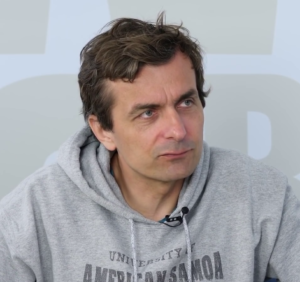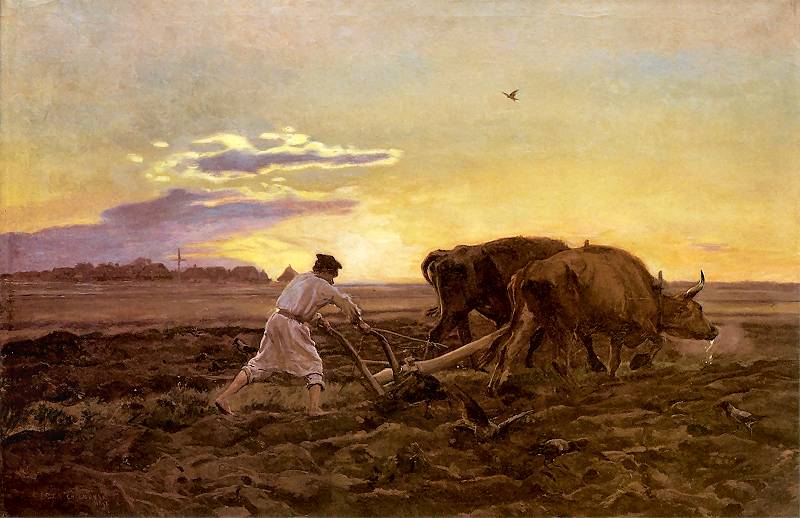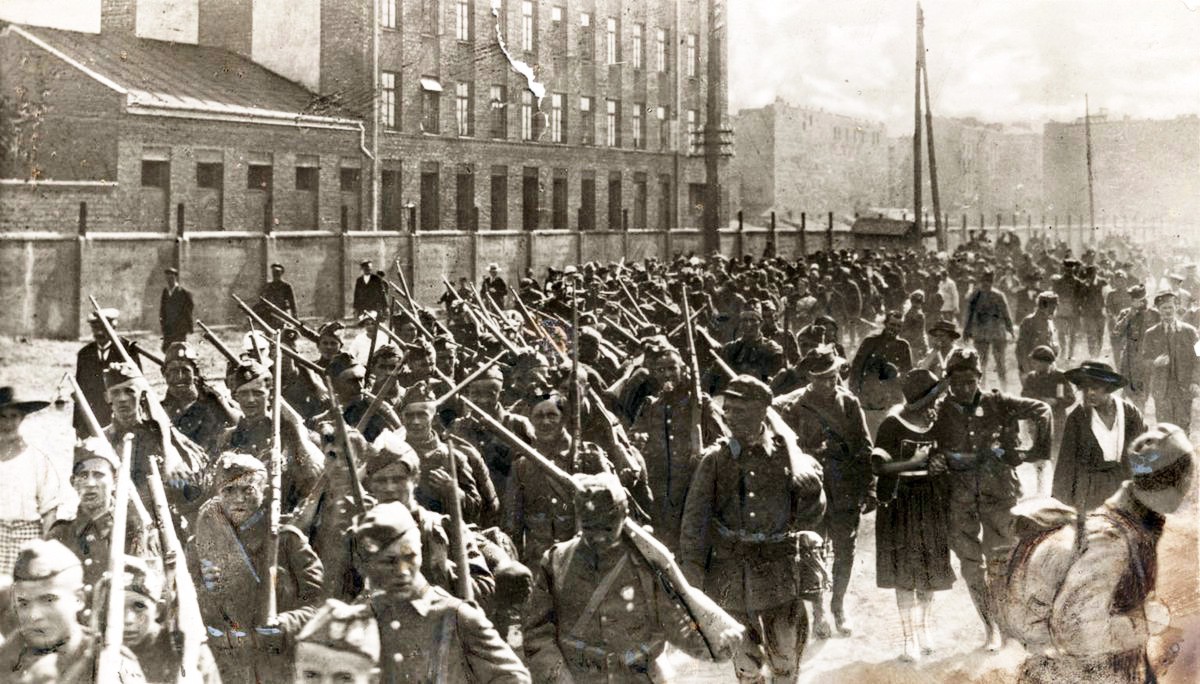My book deals primarily with the continuity of social relations. The most striking thing about this ‘long duration’ turns out to be the fact that the mechanisms of domination and the relations of subordination of ‘the people’ to the ‘elite’ are more durable than even the most revolutionary and drastic changes. You can change people in the structure of power, but the relations of domination remain largely the same,’ says Prof. Adam Leszczyński, author of Ludowa historia Polski [The People’s History of Poland] interviewed by Dr Mikołaj Mirowski.
Why did you write this book?
First of all, I saw the need to show the whole history of Poland from the beginning until almost the present time from a different perspective than it has been shown so far. This is not the perspective of the ‘elite’, but a look from the point of view of the peasant strata, which is basically 90 percent of the population of our country. This required a thorough and radical reworking of the entire story of our homeland’s past. Above all, it required a departure from the dominant positivist-nationalist model. These two elements do not always mean the same thing, but are sometimes identified with each other.
We did not have such a comprehensive ’people’s’ view of Polish history?
No, we have not. But perhaps it is worth saying first what this book is not.
What is it not?
It is not a traditional narrative: that there were wars and kings, that there were partitions and annexations, and that Poland experienced successive occupations. It is not a story about how we had great or less great leaders or generals, more or less successful rulers. This book is about something else. It is a story about people who worked for these kings or commanders. This was the basic aim.

And how did you build this story?
Firstly, it was necessary to change the periodisation, which is usually based uncritically on political events. In general, however, I tried in this book to move away from the primacy of politics in a treaty-war perspective. In fact, many events from this order, various armed conflicts or changes at the top of power do not appear in my book at all. This is because, in my view, such events often had little meaning for the popular classes. In short, this is not a story about the march of the Polish nation through history under the leadership of elites – mainly men and Catholics. Such a perspective did not interest me. Much more important and interesting for me was the social conflict that took place in Polish history within our community.
I have the impression that the internal social conflicts were and are often belittled in Polish historiography, considered insignificant, because the Polish community is perceived in terms of a ‘big family’. And if they are mentioned, they are treated as caused by ‘aliens’, i.e. partitioners, Jews, communists, etc., which also did not prompt serious reflection: they were the work of the enemy. Meanwhile, I was interested in the socio-economic division within Polish society (in the ethnic sense, by the way, not only Polish!) and the related rivalry for power and income distribution.
In this case, how do you define the main character of the book, ‘the people’? Who is part of ‘the people’?
Some readers may unequivocally identify ‘the people’ with the peasants, or as it is more scientifically referred to – the peasantry. Of course, the majority of ‘the people’ were peasants, and have been for a large part of our history. It should be recalled straight away that we had a very interesting discussion in the past – what the term ‘the people’ means. The most important of these took place at the end of the 19th century in the weekly Głos, where future National Democrats argued with future Socialists. Both groups knew that democratic, massified Polish politics had to be based on the popular strata. While the Socialists – which stemmed from the Marxist doctrine, later decisive for their political defeat – gave priority to factory workers (and there were very few of them, several hundred thousand even before the First World War), the National Democrats defined ‘the people’ much more broadly, and spoke of the entire working class, i.e. people who made a living from the work of their own hands.
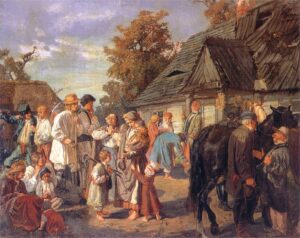
I, on the other hand, call ‘the people’ those who are in a structural relationship with the authorities. They are ones who are governed. These are the people who are deprived of the surplus they produce, the people dominated by an ‘elite’, objectified, and expected to obey. In different periods of Polish history, this was about 90 percent of the society, but of course the composition of ‘the people’ understood in this way was changing. And so in 1989 it had a completely different social composition than for example in 1794.
In my opinion, your book is mainly, but not only, a history of emancipation of ‘the people’ understood in this way. Let me remind you of the subtitle of the work that can be translated as ‘History of exploitation and resistance. The mythology of domination’. Starting from the 15th/16th century, we follow these struggles until the breakthrough of 1989. So what is the conclusion of the book?
That’s right, this is, of course, the history of emancipation, which is dialectical in nature, because it takes place on the principle of two steps forward and one step back. Such cycles of promises made by the ‘elites’ to ‘the people’, some of which are fulfilled and some not. All these offers for ‘the people’ take place in such a convulsive, highly exhausted way, with strong reluctance on the part of the elites. This dialectics of emancipation is related to a certain model of Polish politics, which is described in the book as a competition of ‘elites’ for political support of the popular masses.
In the model I propose – please remember that such an approach is always a certain simplification – we have two actors: one is ‘the people’, treated as a whole, and the other is the ‘elites’. The latter may be native or imperial, i.e. foreign, or there may be various native ‘elites’ representing heterogeneous interest groups. In order to obtain power or to consolidate it, the ‘elites’ need the support of ‘the people’. This usually happens at times of some kind of crisis.
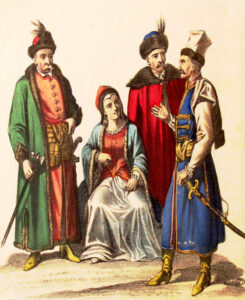
What, from this point of view, is the ‘transaction’ between the elites and the people?
These proposals have two dimensions. The first is communitarian or identity-related – the elite formulates a certain vision of the community in which ‘the people’ are supposed to occupy an important place. The second dimension is, roughly speaking, simply the proposal of certain material benefits, which nevertheless have an emancipatory dimension.
Let us try to refer to a specific example from history.
Here you go. If we look at what I have said from the perspective of, for example, the Kościuszko Uprising, we have a democratic (for those times), progressive ‘elite’ of conspirators, which, by the way, did not enjoy excessive popularity among the masses of the nobility. The conspirators make a proposal to the popular strata (in this case the peasantry): a proposal to recognise limited peasant rights, including above all personal freedom, and certain material privileges. This vision was codified in a document issued by Kościuszko in Połaniec – the Proclamation of Połaniec.
As we know, due to the defeat of the Kościuszko Uprising and the partitions of Poland, peasants were finally granted personal freedom, at least in the Duchy of Warsaw, created under Napoleon’s wing, in 1807. Only 13 years had passed since the insurrection, but this proposal ‘was already on the table’, it was something completely real – it was impossible to ignore.
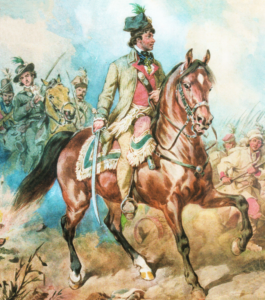
Let us look from the angle of the ‘deal with the elites’ at another event, the 1905 revolution, where there are three actors. There is the socialist elite from the Polish Socialist Party (Polish acronym ‘PPS’), the National Democracy offering a nationalist vision, and finally the Russian invader, exercising undivided political power.
What do the socialists promise, trying to rouse the people to fight the Russian Tsar? A Polish democratic republic and workers’ rights – i.e. trade unions, workers’ unions, better working conditions, higher wages, etc. What do the National Democrats promise? A completely different, traditional vision of community. Its foundations are to be the church, religion, authority, and an important feature – the exclusion of Jews (obviously anti-Semitism will with time become an increasingly important element of the community offer to ‘the people’). The offer of National Democracy is also ‘social solidarity’, i.e. cooperation rather than conflict, according to the idea of ‘nation as a big family’. There is no conflict here with the owners: we are one nation and we work together for the common good.
Thus one can see two proposals (by the PPS and the National Democrats) put forward by a broadly defined ‘elite’ and sharply contrasting with each other. A specific feature of this model of Polish politics was that the promises made were not kept as long as the elite managed to seize power.
Why? After all, it was not always due to ill will.
The promises were not kept because they went too far, violating the vital interests of that ‘elite’. On the other hand (as long as the elite actually gained power), they could not be reneged on completely. That is why emancipation took place on a dialectical basis. Although the commitments were not fulfilled at the particular moment of the breakthrough, they passed from the sphere of utopia into that of real politics. They became a tangible political project. Thanks to this, at some subsequent turn, crisis or solstice, a programme improving the lot of ‘the people’ turned out to be feasible. Thus it can be seen that ultimately the history of emancipation is an optimistic history, although a terribly gloomy one, and also a bloody one in its details.
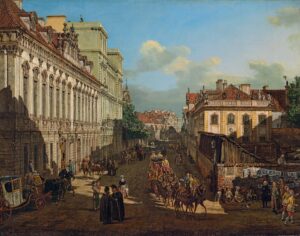
Was there an alternative to this model of change?
This is an interesting question. I think there is a consensus among historians on the choice of Poland’s economic path from around the mid-15th century onwards. The reason was, in simple terms, the demand for grain, which Western Europe was buying from us. This demand prompted the subordination of production and, consequently, of the social structure to this demand. This is how the most powerful burden for ‘the people’ and for the Polish peasantry was born, namely serfdom.
In the nineteenth century, the system of serfdom was dismantled step by step, in a very complicated political environment, at a varied pace, in different parts of the Polish territories under partition, and according to different rules. But the sequence of these steps – obtaining freedom from the jurisdiction of the heir, personal freedom, and finally the enfranchisement of land – was similar. Let us remember that the process of this dismantling took a century. On the other hand, the serfdom system in its crystallised, closed form prevailed for about 250 years. That is a long time. It seems to me that these changes could not have taken place in any other way. Let us also remember that even half a century after the enfranchisement in the Kingdom of Poland in 1864, before the First World War, but also after its end, fears of the return of serfdom were still alive in the countryside (and such testimonies are well documented).
Let us therefore return to your proposal for a periodisation of Polish history. The first important date is 1520, why?
This is obviously a conventional date. However, in a symbolic way it shows the moment of transformation of the economic system. The Statute (privilege) of Toruń, issued by King Sigismund I the Old, introduced the obligation of serfdom in the amount of one day a week. There is a lively debate as to how much of this statute was a top-down decision of the ruler, and to what extent it was a sanctioning of a state of affairs which had already existed earlier. Regardless, this date should be seen as the beginning of what we might call ‘serfdom slavery’. This decidedly gloomy period of tightening the screws ends after more than two centuries, in 1768. At that time, by virtue of the Sejm’s decision, killing a peasant by his master becomes a crime and is punishable (at least in theory). The final end of serfdom was the Tsarist decree of 1864 that we have been talking about.
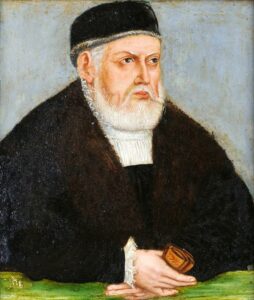
So how to look at the history of Poland after 1864 through ‘the people’s’ i.e. workers and peasants’ glasses? Throughout the 19th century (and in fact since the 1794 Kościuszko Uprising), the process of the formation of a modern nation is going on. ‘The people’ (peasants, and with time also workers) are, in a way, invited to participate in this process and are an element of it. This is all the more evident after the regaining of independence in 1918. ‘The people’ in the Second Republic have a share in power, we have two peasant parties and Wincenty Witos is twice Prime Minister. Having its own state therefore gives ‘the people’ a lot, and certainly much more than the partitioners.
I think this is largely an illusion. Firstly, the living standard of the majority of the population in the Second Republic was lower than before 1914. Of course, this was due to a number of reasons, including war damage. It was also a result of a change in the economic structure. The Second Republic came into being as a result of the merging of various regions which, formerly within the borders of foreign countries, had been peripheral areas for those economies. This was the case with Greater Poland, Galicia and the Borderlands, with the exception of Silesia, only half of which, as we know, became a part of Poland. In addition, a large part of the industry of the former Polish Kingdom produced for eastern markets, which closed after 1918. Thus, the economic shock added to the war damage was huge indeed. This alone made it difficult to return to the quality of life before 1914.
Moreover, building a modern state of one’s own was an incredibly expensive undertaking, and someone had to pay for it. Who could? In a country that was 70 per cent agricultural, with industry playing a relatively minor role, weakened and lacking its own capital – this had to fall mainly on the shoulders of the peasants. Of course, every social group participated in the building of the Second Republic, but there was only one group that gained. And that group was the clerical intelligentsia, or in fact one could say that it was simply the Polish intelligentsia.
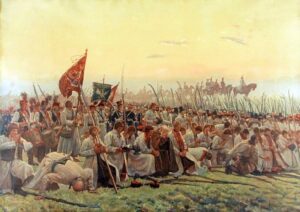
This situation is particularly striking when one compares memoirs from that period. Those of intelligentsia families, especially ones written by children, are descriptions of a paradise lost, a country where everything was in its right place, life was peaceful and fairly prosperous, the money may not have been pouring in, but there was no abject poverty. On the other hand, memoirs of workers and peasants show a drastic level of deprivation even in comparison with the period before the First World War. This was mainly due to the fact that initially interwar Poland was very poor and yet it had to finance a costly state apparatus, including the army. Incidentally, the army was a powerful career vehicle (I am thinking of the officer corps), but also, and above all, for the intelligentsia or landowning elites, now few in number but influential. It is funny that the historiography of the Polish People’s Republic (Polish acronym ‘PRL’), criticising the Second Republic, used the phrase ‘bourgeois Poland’. The Second Republic was a very poor country, there were not many rich people who could be counted among the ‘bourgeoisie’. Nevertheless, the intelligentsia had relatively the best life.
But did the Second Republic not have any emancipation successes to its credit? Let us recall, for example, the granting of voting rights to women and the entire social package introduced by Jędrzej Moraczewski’s government, with the eight-hour working day, compulsory health insurance for employees and the right to strike.
In answering, however, I will start with the model of behaviour of the ‘elites’ and the promises made to ‘the people’ that I have proposed. In my opinion, the Second Republic functioned according to this model: it made certain pledges to the popular strata when the very existence of the state was threatened. We can point to two such key moments: 1918 and the revolutionary ‘rocking’ in the starved cities, and 1920 and the Bolshevik offensive on Poland. In the first case (1918), the response of the elites was social legislation, with the eight-hour working day adopted by the Moraczewski government that you mention. In 1920, the peasants were promised land reform in the hope that they would defend independence.
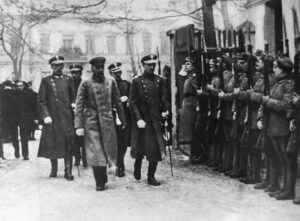
Agreed, these were important gains, the problem is that neither of them were kept. The eight-hour working day was not observed everywhere – in many factories (not to mention crafts and agriculture) this rule was ignored. The Polish state did not enforce these regulations, and this was a conscious political decision. In the book I quote Halina Krahelska’s publications from 1919–1921 and 1927–1931, the deputy chief labour inspector, in which she presented a picture of notorious violations of workers’ rights. The State Labour Inspectorate was underfunded and lacked the capacity to act, just as it does today. Inspectors could only impose very small fines, had little money and few powers. Moreover, they were treated by the industrial circles as enemies, almost as Bolshevik agents.
Of course, I would not demonise this, because it is part of the social competition for power and resources. But on the other hand I would advise against idealising this past. Nevertheless, I agree that the very making of such demands as the eight-hour working day or the agrarian reform were extremely important and had an emancipatory value.
Let us go further. The Second World War was the end of Poland as remembered by the three previous generations of Poles. After 1945, a completely different social reality came. Meanwhile, you describe the PRL period in terms of ‘long duration’ and a certain reproduction of the habits of the ‘elites’ towards ‘the people’. You also did not succumb to the myth of the Polish People’s Republic, which, with all its dark sides, was supposed to achieve ‘a great emancipation of the exploited strata”.
My book is mainly about the continuity of social relations. The most striking thing about this ‘long duration’ is that the mechanisms of rule and the relations of subjection of ‘the people’ to the ‘elite’ are more durable than the most revolutionary and drastic changes brought about by the First World War and the post-war period. This is fascinating. You can change people in the power structure, but the relations of domination remain largely the same. In a sense, this post-1945 society is, to put it ugly, ‘made anew’, but it is still the same Poland when it comes to the paternalism of the ‘elites’ or the relations prevailing in workplaces, factories. Also, if we look at relations between ‘the people’ and the state administration, it turns out that even such a gigantic upheaval changed almost nothing. It is also worth noting that the emancipation of the PRL was paradoxical, somewhat similar to that of the Second Republic. The Polish People’s Republic made various promises of emancipation, after which it largely adapted to the old, traditional power structures.
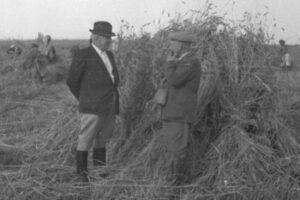
Only that the PRL was about legitimising non-sovereign power, while the Second Republic was sovereign…
Agreed, it was also one of several forms of legitimising that system. Of course, the authorities of the Polish People’s Republic liked to say that here we have a state of workers and peasants. Only that quite often the workers and peasants had a completely different opinion about it. Interestingly, the level of disillusionment of the authorities with the fact that workers protest and organise strikes, that peasants revolt and do not want, for example, to be collectivised, was similar to the level of disillusionment of the nobility and its reaction to peasant revolts. It was the same reflex of deep astonishment: How is this even possible? After all, we want the best for them!.
That is why for me the story of communist-ruled Poland is a story about the permanence of the Polish social structure and the structure of power. In this sense, as lofty as it may sound – Poland is eternal! If you look at it this way – the PRL was very Polish. Of course, it was not sovereign, it was subordinate to the USSR, its ideology was partly imposed from outside, and it was largely built by people who were foreign agents – all this is true. However, as far as the structure was concerned, what the authorities looked like, what social relations were like, I would say that it was 100% Polish.
